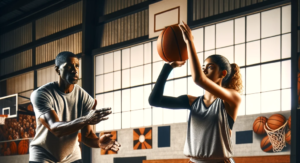
If you are indeed responsible for your own success, then you want to read, learn, and experiment with “Pre-Season Basketball Trust Building Exercises and Fun.”
In the world of select/AAU, high school and college basketball, wins and losses are not solely determined by the points scored on the court but by the bonds forged off it.
Building trust and connection among players is the cornerstone of a successful team, especially during the pre-season when the foundation for teamwork and chemistry is laid.
While trust-building exercises have often been associated with eye-rolling clichés, this guide unveils a fresh perspective. For college basketball teams, trust-building can be both innovative and enjoyable.
Whether you’re a coach, captain, or player, this comprehensive ‘Pre-Season Basketball Trust Building for Team Chemistry: Player Action Guide’ offers a playbook of engaging exercises, both on and off the court, designed to strengthen trust, enhance social intelligence, and foster inclusive behavior. Get ready to elevate your team’s spirit and performance in a way that is not only effective but also ridiculously fun.”
Feel free to make any adjustments or let me know if you have specific preferences for the introduction.
Certainly, trust-building exercises don’t have to be cliché. Here are some innovative and enjoyable trust-building exercises that your college basketball team may appreciate:
Escape Room Challenge
- Desired Outcome: Enhancing problem-solving skills and teamwork.
- Transformation: Collaborate with teammates to solve puzzles and escape from an escape room within a set time limit, fostering quick decision-making and effective communication, essential elements of Team Chemistry Building in Basketball.
- Specific Action: Participate in escape room challenges to build trust and camaraderie among team members, a part of Pre-Season Basketball Preparation.
Blindfolded Obstacle Course
- Desired Outcome: Building trust and communication skills.
- Transformation: Set up an obstacle course, and have players guide each other through it blindfolded, relying on their teammates for guidance and support, contributing to Trust Building Exercises for Basketball Teams.
- Specific Action: Engage in blindfolded obstacle courses to strengthen trust and communication within the team, aligning with Basketball Team Cohesion.
Team-Building Cooking
- Desired Outcome: Encouraging cooperation, decision-making, and creativity.
- Transformation: Organize a cooking session where players work together to prepare a meal, emphasizing the importance of cooperation and creativity, essential for Building Team Chemistry Off the Court.
- Specific Action: Cook together as a team to promote decision-making and creativity, contributing to Teamwork and Trust in Basketball.
Trust Fall Variations
- Desired Outcome: Reinforcing trust and adding an element of excitement.
- Transformation: Try trust fall variations like the “Trust Lean,” where players lean back and rely on their teammates to catch them, adding an element of surprise and excitement to the trust-building process, acknowledging that trust exercises can sometimes be met with skepticism (Trust Building Challenges in Basketball).
- Specific Action: Embrace trust fall variations to strengthen trust with an element of excitement, recognizing that some exercises may seem unconventional but can still be effective. (Okay, I sense some eye rolls on this… read on player!)
Two Truths and a Lie
- Desired Outcome: Enhancing understanding and connection among teammates.
- Transformation: Players take turns sharing two truths and one false statement about themselves, and teammates must guess which statement is the lie, promoting understanding and connection within the team, a crucial part of Teamwork and Trust in Basketball.
- Specific Action: Play “Two Truths and a Lie” to deepen connections and understanding among teammates, aligning with Building Trust Among Teammates.
Human Knot
- Desired Outcome: Encouraging teamwork and problem-solving.
- Transformation: In a circle, players reach across to grab hands with two different people and work together to untangle the human knot without letting go, fostering teamwork and problem-solving, critical elements of Team-Building Drills for Basketball.
- Specific Action: Tackle the human knot challenge to promote teamwork and problem-solving skills, contributing to Effective Communication in Basketball.
Group Juggling
- Desired Outcome: Promoting quick thinking and trust in teammates.
- Transformation: Start with three balls and have players pass them around in a circle. As they become more proficient, add more balls, promoting quick thinking and trust in teammates to catch the ball, essential for Basketball Leadership and Trust.
- Specific Action: Engage in group juggling to enhance quick thinking and trust in your teammates, aligning with Building Stronger Basketball Teams.
Team-Building Challenges
- Desired Outcome: Encouraging teamwork and camaraderie.
- Transformation: Create physical challenges like relay races, tug-of-war, or even a mini-Olympics. These competitive yet fun activities promote teamwork and camaraderie, contributing to Trust Building Strategies in Sports.
- Specific Action: Take on team-building challenges to strengthen teamwork and camaraderie, an integral part of Inclusive Behavior in Sports.
Personal Story Sharing
- Desired Outcome: Building empathy and deeper connections.
- Transformation: Allow players to share personal stories, challenges they’ve overcome, or what motivates them. This helps build empathy and a deeper understanding of each other’s backgrounds, fostering inclusivity and trust, crucial for Building Trust Among Teammates.
- Specific Action: Share personal stories to build empathy and deeper connections within the team, emphasizing the importance of Social Intelligence in Basketball.
Team Movie Night
- Desired Outcome: Extracting key takeaways for team dynamics.
- Transformation: Organize a movie night where players watch an inspirational sports movie together. Afterward, discuss the key takeaways and how they can apply them to their own team dynamics, promoting self-reflection and shared learning, essential for Team Chemistry Building in Basketball.
- Specific Action: Enjoy a team movie night and extract insights for improved team dynamics, contributing to Basketball Team Bonding Activities.
Remember, the key to successful trust-building exercises is to keep them engaging and relevant to your team’s goals. Tailor these activities to suit your college basketball team’s preferences and watch trust and camaraderie grow in a fun and enjoyable way.
Looking for More Trust Building Exercises for Pre-Season Team Chemistry?
Team Campfire Stories
- Desired Outcome: Bonding through laughter and personal connections.
- Transformation: Gather around a “campfire” (real or simulated with lights) and have players share funny or memorable stories from their lives, fostering connections through laughter and personal anecdotes, a crucial part of Pre-Season Basketball Trust Building.
- Specific Action: Share campfire stories to strengthen bonds through laughter and personal connections, aligning with Trust Building Exercises for Basketball Teams.
Team Song Creation
- Desired Outcome: Fostering appreciation for individuality and teamwork.
- Transformation: Divide the team into small groups and challenge them to create a song or rap that incorporates everyone’s name and a positive message about teamwork. Then, perform the songs for the whole team, promoting creativity and appreciation for each other’s unique contributions, essential for Team Chemistry Building in Basketball.
- Specific Action: Collaborate on song creation to celebrate individuality and teamwork, contributing to Building Team Chemistry Off the Court.
Team Talent Show
- Desired Outcome: Showcasing and celebrating unique talents.
- Transformation: Host a talent show where players can showcase their unique talents, whether it’s singing, dancing, magic tricks, or comedy. This fosters appreciation for each other’s individuality and hidden talents, promoting inclusivity and trust, crucial for Basketball Team Cohesion.
- Specific Action: Participate in a talent show to celebrate unique talents within the team, aligning with Pre-Season Basketball Preparation.
Team Trivia Night
- Desired Outcome: Promoting healthy competition and teamwork.
- Transformation: Organize a trivia night with sports-related questions and challenges. Teams compete against each other, promoting healthy competition and teamwork, essential elements of Trust Building Exercises for Basketball Teams.
- Specific Action: Engage in a trivia night to enhance teamwork and healthy competition, contributing to Building Team Chemistry Off the Court.
Outdoor Adventure
- Desired Outcome: Strengthening bonds through teamwork and problem-solving.
- Transformation: Plan an outdoor adventure like hiking, camping, or kayaking. Outdoor activities often require teamwork and problem-solving, strengthening bonds in a natural setting, crucial for Team Chemistry Building in Basketball.
- Specific Action: Embark on an outdoor adventure to build teamwork and problem-solving skills, emphasizing Basketball Team Bonding Activities.
Board Game Tournament
- Desired Outcome: Encouraging strategic thinking and teamwork.
- Transformation: Set up a board game tournament with games like Monopoly, Scrabble, or Pictionary. It’s a fun way to encourage strategic thinking and teamwork, essential for Trust Building Strategies in Sports.
- Specific Action: Compete in a board game tournament to enhance strategic thinking and teamwork, aligning with Inclusive Behavior in Sports.
Themed Costume Practice
- Desired Outcome: Adding an element of fun and creativity to training.
- Transformation: Surprise the team by having everyone show up to practice in themed costumes (e.g., superhero day), adding an element of fun and creativity to training sessions, fostering inclusivity and a relaxed atmosphere, crucial for Effective Communication in Basketball.
- Specific Action: Participate in themed costume practices to infuse fun and creativity into training, contributing to Basketball Leadership and Trust.
Memory Wall
- Desired Outcome: Sparking conversations and connections.
- Transformation: Create a memory wall where players post pictures or mementos from memorable moments in their lives. This can spark conversations and connections among teammates, promoting shared memories and trust, essential for Building Stronger Basketball Teams.
- Specific Action: Contribute to the memory wall to spark conversations and connections, emphasizing the importance of Social Intelligence in Basketball.
Secret Compliments
- Desired Outcome: Boosting morale and team spirit.
- Transformation: Have each player draw a teammate’s name and write a heartfelt compliment or message anonymously. Share these compliments at a team meeting to boost morale and strengthen team spirit, fostering positivity and trust, crucial for Inclusive Behavior in Sports.
- Specific Action: Share secret compliments to boost morale and team spirit, aligning with Teamwork and Trust in Basketball.
Basketball Scavenger Hunt
- Desired Outcome: Strengthening teamwork and problem-solving.
- Transformation: Organize a basketball-themed scavenger hunt with clues and challenges related to the sport. Teams work together to complete tasks and find hidden items, promoting teamwork and problem-solving, essential for Pre-Season Basketball Player Development.
- Specific Action: Engage in a basketball scavenger hunt to build teamwork and problem-solving skills, contributing to Building Trust Among Teammates.
These activities focus on creating genuine connections and shared experiences, making them ideal for building trust and camaraderie within your college basketball team in a relaxed and enjoyable way.
Pre-Season Basketball Trust Building for Team Chemistry in the Social and Online World
Building trust and camaraderie within a college basketball team can also be achieved through social media and online group interactions. Here are some ideas tailored to the online space:
Virtual Basketball Team Challenges
- Desired Outcome: Enhancing skills and teamwork remotely.
- Transformation: Create weekly or monthly challenges that players can participate in remotely, focusing on basketball-related skills, fitness routines, or fun off-court activities. Encourage players to share their progress and experiences on social media platforms using a specific hashtag, promoting engagement and unity within the team.
- Specific Action: Participate in virtual team challenges to enhance skills and teamwork remotely, aligning with Pre-Season Basketball Trust Building.
Team Podcast or Webinar Series
- Desired Outcome: Deepening connections and shared learning.
- Transformation: Host regular podcasts or webinars featuring players, coaches, and even alumni discussing various aspects of the game, team dynamics, and personal experiences. This allows team members to connect on a deeper level and learn from each other, fostering knowledge sharing and building trust.
- Specific Action: Engage in team podcast or webinar sessions to deepen connections and shared learning, emphasizing the importance of Team Chemistry Building in Basketball.
Online Team Building Games
- Desired Outcome: Fostering teamwork and friendly competition online.
- Transformation: Use platforms like Zoom or specialized team-building apps to play online games together. Virtual escape rooms, trivia, or online multiplayer games can foster teamwork and friendly competition, promoting engagement and camaraderie in the online space.
- Specific Action: Play online team-building games to strengthen teamwork and friendly competition online, aligning with Trust Building Exercises for Basketball Teams.
Social Media Challenges
- Desired Outcome: Encouraging creativity and engagement.
- Transformation: Create team-specific challenges on social media platforms like TikTok, Instagram, or Twitter. These could involve players sharing their basketball tricks, favorite basketball moments, or even dance challenges set to popular songs. Promote creativity and engagement among team members and fans.
- Specific Action: Participate in social media challenges to encourage creativity and engagement, contributing to Building Team Chemistry Off the Court.
Player Takeovers
- Desired Outcome: Connecting with fans and teammates on a personal level.
- Transformation: Allow different players to take over the team’s social media accounts for a day. They can give followers a behind-the-scenes look at their lives, share training routines, or engage in Q&A sessions to connect with fans and teammates, fostering personal connections and trust.
- Specific Action: Take over the team’s social media accounts to connect with fans and teammates on a personal level, emphasizing the importance of Teamwork and Trust in Basketball.
Storytelling Sessions
- Desired Outcome: Sharing personal experiences and building empathy.
- Transformation: Host storytelling sessions where players share personal stories or experiences. This can be done through live streams, video posts, or written blogs. Encourage teammates to engage with each other’s stories and offer support, promoting empathy and understanding within the team.
- Specific Action: Share personal stories through storytelling sessions to build empathy and understanding, contributing to Team Chemistry Building in Basketball.
Online Book Club
- Desired Outcome: Fostering discussions and shared insights.
- Transformation: Start an online book club focused on sports-related or personal development books. Reading and discussing books together can lead to meaningful conversations and shared insights, promoting knowledge sharing and trust.
- Specific Action: Join the online book club to foster discussions and shared insights, aligning with Basketball Team Cohesion.
Weekly Check-Ins
- Desired Outcome: Providing emotional support and connection.
- Transformation: Set up a weekly virtual check-in where team members share highs and lows from their week, whether related to basketball or personal life. It provides a space for emotional support and empathy, fostering emotional connections and trust.
- Specific Action: Participate in weekly check-ins to provide emotional support and connection, emphasizing the importance of Pre-Season Basketball Preparation.
Goal-Setting Workshops
- Desired Outcome: Articulating aspirations and team goals.
- Transformation: Hold virtual goal-setting workshops where players discuss their individual and team goals for the upcoming season. Encourage them to articulate their aspirations and plans for improvement, promoting shared aspirations and trust.
- Specific Action: Attend goal-setting workshops to articulate aspirations and team goals, contributing to Trust Building Strategies in Sports.
Video Challenges
- Desired Outcome: Showcasing skills and motivation.
- Transformation: Create video challenges that encourage players to showcase their skills or share motivational messages. These can be shared on platforms like YouTube or Instagram for the wider community to see, promoting skills display and motivation among team members and fans.
- Specific Action: Participate in video challenges to showcase skills and motivation, aligning with Inclusive Behavior in Sports.
Highlight Reels
- Desired Outcome: Reminiscing about memorable moments.
- Transformation: Compile highlight reels or “best of” videos from past seasons to reminisce about memorable moments. Share these on social media to boost team spirit and nostalgia, fostering a sense of nostalgia and unity among team members and fans.
- Specific Action: Contribute to highlight reels to reminisce about memorable moments, emphasizing Social Intelligence in Basketball.
Online Fundraisers
- Desired Outcome: Coming together for a shared purpose.
- Transformation: Organize online fundraisers for charitable causes that are important to the team. It’s a way for players to come together for a shared purpose beyond basketball, promoting a sense of unity and trust in the broader community.
- Specific Action: Participate in online fundraisers to come together for a shared purpose, contributing to Basketball Leadership and Trust.
Mentorship Program
- Desired Outcome: Providing guidance and support.
- Transformation: Establish a mentorship program within the team, pairing veteran players with newcomers. They can connect through video calls, providing guidance and support, fostering mentorship and trust within the team.
- Specific Action: Engage in the mentorship program to provide guidance and support, aligning with Building Stronger Basketball Teams.
By leveraging social media and online group interactions, your college basketball team can stay connected, build trust, and maintain a sense of unity even when physically apart. These virtual initiatives can enhance team cohesion and morale, making your team stronger both on and off the court.
Conclusion
In conclusion, trust and camaraderie are the unspoken champions of any college basketball team’s success. Through innovative and enjoyable trust-building exercises, both on and off the court, you’ve discovered the power of strengthening bonds, enhancing social intelligence, and fostering inclusive behavior.
As you embark on this journey to build a stronger, more connected team, remember that trust is the foundation upon which victories are built. So, gather your teammates, embrace these exercises, and watch as your team’s chemistry soars to new heights.
The next step is yours, and it begins with a simple leap of trust—a leap that can take your team to greatness. Onward to a season filled with unity, resilience, and triumph!


 Shooting is a pivotal component in basketball, and biomechanics play an essential role in mastering this skill. By understanding the forces, angles, and motions involved in shooting, players can fine-tune their technique to increase accuracy and consistency. It involves analyzing wrist flexion, elbow and knee angles, and the release point to determine the optimal shooting form. Biomechanical studies on shooting can lead to personalized recommendations for each player, enabling them to maximize their shooting potential and improve overall game performance.
Shooting is a pivotal component in basketball, and biomechanics play an essential role in mastering this skill. By understanding the forces, angles, and motions involved in shooting, players can fine-tune their technique to increase accuracy and consistency. It involves analyzing wrist flexion, elbow and knee angles, and the release point to determine the optimal shooting form. Biomechanical studies on shooting can lead to personalized recommendations for each player, enabling them to maximize their shooting potential and improve overall game performance.
 advanced basketball shooting techniques: beyond the basics.
advanced basketball shooting techniques: beyond the basics.



